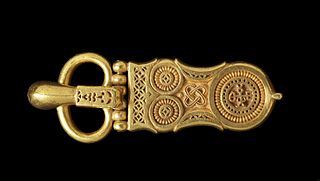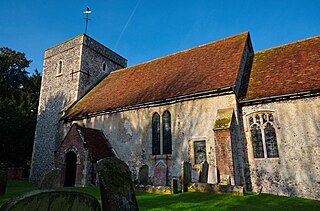
Kings Worthy is a village and civil parish in Hampshire, England, approximately two miles north-east of Winchester. Kings Worthy was a tithing of Barton Stacey when the Domesday Book was written.

Eastry is a civil parish in Kent, England, around 2+1⁄2 miles (4 km) southwest of Sandwich. It was voted "Kent Village of the Year 2005".

Horned helmets were worn by many people around the world. Headpieces mounted with animal horns or replicas were also worn from ancient times, as in the Mesolithic Star Carr. These were probably used for religious ceremonial or ritual purposes, as horns tend to be impractical on a combat helmet. Much of the evidence for these helmets and headpieces comes from depictions rather than the items themselves.

Ash is a village and civil parish in the Dover district of east Kent about three miles west of Sandwich.

Hilda Roderick Ellis Davidson was an English folklorist. She was a scholar at the University of Cambridge and The Folklore Society, and specialized in the study of Celtic and Germanic religion and folklore.

Wingham is a village and civil parish in the Dover District of Kent, England. The village lies along the ancient coastal road, now the A257, from Richborough to London, and is close to Canterbury.

The quoit brooch is a type of Anglo-Saxon brooch found from the 5th century and later during the Anglo-Saxon settlement of Britain that has given its name to the Quoit Brooch Style to embrace all types of Anglo-Saxon metalwork in the decorative style typical of the finest brooches. The brooches take their modern name from the rings thrown in the game of quoits, and have the form of a broad ring, or circle with an empty centre, usually in bronze or silver, and often highly decorated. The forms are in a very low relief, so contrasting with other early Anglo-Saxon styles, with detail added by shallow engraving or punching within the main shapes. Dots or dashes are often used to represent fur on the animal forms, as well as lines emphasizing parts of the body. They are fixed with a single, straight hinged pin like those of other Anglo-Saxon ring or Celtic brooches and are further defined by the presence of a slot and pin-stops on the ring.
The year 1959 in archaeology involved some significant events.
The year 1961 in archaeology involved some significant events.
The year 1964 in archaeology involved some significant events.

A belt buckle is a buckle, a clasp for fastening two ends, such as of straps or a belt, in which a device attached to one of the ends is fitted or coupled to the other. The word enters Middle English via Old French and the Latin buccula or "cheek-strap," as for a helmet. Belt buckles and other fixtures are used on a variety of belts, including cingula, baltea, baldrics and later waist-belts.

Tilmanstone is a small village and civil parish in Kent, in the South East of England, near Eastry, a much bigger and more developed area. Tilmanstone no longer has a village school; however, the independent Northbourne Park School is close to the parish boundary. The name of Tilmanstone has historically been famous for its colliery, although it is located in the village of Eythorne, operated from 1906 to 1986 as one of the four main pits of the Kent coalfield. The population taken at the 2011 Census also included that of the nearby hamlet of Ashley.

Ham is a hamlet near the town of Sandwich in Kent, England, within the parish of Northbourne. The population is included in the civil parish of Eastry.

Northbourne is a village and civil parish near Deal in Kent, England. It has a public house, The Hare and Hounds, a primary school and is the home of the current, and prior, Baron Northbourne. It should not be confused with an area in Bournemouth of the same name.

Betteshanger is a village near Deal in East Kent, England. It gave its name to the largest of the four chief collieries of the Kent coalfield. The population of the village is included in the civil parish of Northbourne.
George Speake, is an English art historian and archaeologist. He is an Honorary Research Fellow at the Institute of Archaeology at Oxford, and "a leading authority on Anglo-Saxon animal art." Currently Speake is the Anglo-Saxon Art and Iconography Specialist for the Staffordshire Hoard conservation team, and is working on the reconstruction of the Staffordshire helmet.
Finglesham Anglo-Saxon cemetery is a place of burial that was used from the sixth to the eighth centuries CE. It is located adjacent to the village of Finglesham, near Sandwich in Kent, South East England. Belonging to the Anglo-Saxon period, it was part of the much wider tradition of burial in Early Anglo-Saxon England.

The Miner's Way Trail is a long-distance circular footpath in England, starting at Sholden, Kent. Linking up the coalfield parishes of East Kent. Including; the parishes of Deal, Ash, Aylesham, Chillenden, Eastry, Eythorne, Elvington, Goodnestone, Nonington, Northbourne, Coldred, Staple, Tilmanstone and Wingham.
Sonia Chadwick Hawkes, was a leading specialist in early Anglo-Saxon archaeology, described as a "discerning systematiser of the great array of Anglo-Saxon grave furnishings". She led major excavations on Anglo-Saxon cemeteries at Finglesham in Kent and Worthy Park in Hampshire.

















